The Planets
Please wait until this page is fully loaded before
selecting one of the planet name links below.
The five prominent planets in our sky (Mercury,
Venus, Mars, Jupiter,
and Saturn) can usually be recognized by their brightness
relative to most stars and their generally steady (rather than "twinkling")
appearance. The planets appear to change position against the starry background
over the course of days and weeks, another feature which will help you
recognize them. At any given time, one or more of these planets may be
hidden near the sun, so you may have to wait several months before you
can say you've seen them all. The current positions of the planets can
be found in a monthly astronomy magazine such as Astronomy
or Sky and Telescope.
Once you are familiar with the sky, you will be able to identify the bright
planets at a glance.
Jupiter, the largest planet,
is normally the second brightest planet in the sky (behind Venus). It is
always brighter than any fixed star and shines a cream color. Through a
telescope, Jupiter appears as a small, bright disk surrounded by at least
a couple of its four major moons (the Galilean satellites). Look more closely,
and you may see two or three reddish stripes running across the disk of
Jupiter. These are cloud belts. The famous Great Red Spot of Jupiter is,
unfortunately, not obvious in small telescopes.
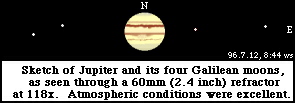

SKETCH: Comet Impact Sites
on Jupiter
CCD
Images of Jupiter and Saturn
Saturn, the second largest planet,
is usually as bright as the brightest fixed stars. It shines an orangish-yellow.
Through a small telescope, an apparently single ring is seen surrounding
the planet and separated slightly from the main disk. Larger telescopes
reveal divisions between the rings. Look for cloud belts, which are not
as prominent on Saturn as on Jupiter, and also look for the shadows which
the rings and disk cast on each other. Saturn has an extensive satellite
system. One of its moons, Titan, can be seen in any telescope when it is
reasonably far from the planet's disk and rings. Telescopes in the six
to eight inch range will often reveal other moons, including Rhea, Dione,
Tethys, and Iapetus.


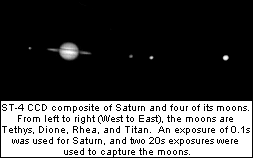
CCD
Images of Jupiter and Saturn
Because of its closeness to Earth
and the high reflectivity of its clouds, Venus is the brightest
planet in our sky. It shines pure white, and can be dazzling when it is
at its brightest. It is often possible to see Venus in very bright twilight
or even
when the Sun is up. Unlike Jupiter and Saturn, Venus is an inferior
planet (its orbit is closer to the Sun than is the Earth's). This has
several consequences, one of which is that Venus is found pretty near the
Sun, in the morning or evening twilight. When Venus disappears from the
morning sky, you will have to wait several months to view it in the evening
sky; on the other hand, the transition from evening to morning sky is made
quite quickly, within a week or so.
Venus's main claim to fame through the telescope is also
a result of its "inferiority": Venus appears to go through phases like
the Moon's. When Venus is entering the evening sky, it is far away from
Earth on the other side of the Sun. At these times, it appears as a very
small, nearly full disk. During the middle of its apparitions, when it
is at its greatest distance from the Sun in our sky (but closer to Earth
than at full phase), Venus appears half-lit like a quarter Moon. As Venus
passes between the Earth and the Sun, the diameter of its disk increases
(it is at its closest to Earth). We are also seeing less of Venus's sunlit
side at this time, so its phase shrinks to a crescent. It is also sinking
into the evening twilight at this time. When it passes into the morning
sky, it will start out as a large crescent and gradually progress toward
full phase. If you are trying to see the phase of Venus through a small
telescope or binoculars, you might want to view
it during twilight or daylight when Venus is higher in the sky.
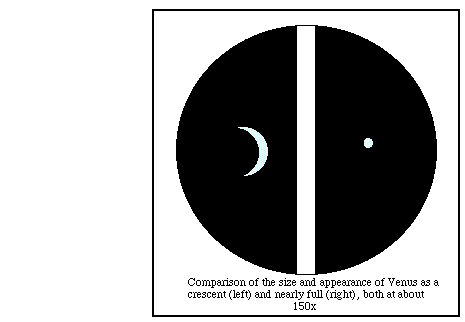
SKETCH: Moon-Venus
Conjunction, 1996 July 12.
SKETCH: Crescent
Venus Setting
SKETCH: Cloud Detail on Venus
Mercury has the reputation
of being difficult to see. In fact, it is invisible most of the time because
it is so close to the Sun. Several times during the year, however, Mercury
emerges from the glare and can be easily seen during evening or morning
twilight. The apparitions which are best for a given observer depend upon
the latitude of the observer. When Mercury is far to the south in the ecliptic,
even though it may be far away from the Sun, observers in northern latitudes
will have a difficult time seeing it. Sky
and Telescope, a monthly astronomy magazine, has a column where
you can find out the visibility of Mercury and the other planets during
the month. Mercury usually appears orange, although when it is low in the
sky it will twinkle like a star and give off other colors. Its phases progress
like those of Venus, but are harder to observe in a telescope due to Mercury's
small size and closeness to the horizon. Try a polarizing filter.
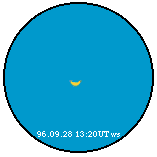 |
Mercury's crescent phase,
sketched as seen through twilight
in a 60mm refractor at 79x. |
Mars, the "Red Planet", is
usually the least impressive. It shines reddish, but presents to the telescope
only a small disk. Every two years, Mars comes to opposition (it is opposite
the Sun in our sky). At this time, it is near its closest approach to Earth
and thus appears brighter and larger than at other times. Only around the
time of opposition can surface features be observed. Some oppositions are
better than others. Because Mars's orbit deviates significantly from a
circle, it will be closer to Earth at some oppositions than at others.
Every 18 years, Mars is as close to Earth as it ever can be. During these
oppositions, Mars's brightness exceeds that of Jupiter, and its disk is
large enough to permit users of small telescopes to pick out its polar
ice caps and the dark markings on its surface.
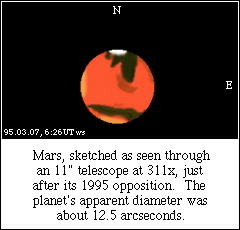
Sketch of Mars with a 60mm refractor
Of the three remaining planets in our solar system, Uranus
can be seen in binoculars or even with the naked eye. The problem is distinguishing
Uranus from the many other stars which are of the same brightness. Sky
and Telescope magazine puts out a finder
chart for Uranus and Neptune every year. In a small telescope, Uranus
can usually be seen as a greenish disk smaller than Mars or Mercury.
Neptune is quite a bit fainter than Uranus. Generally,
a dark sky, the Sky and Telescope finder chart, and a good finder
scope on your telescope are helpful aids in locating it. Neptune's disk
is smaller than that of Uranus and can be difficult to resolve in a small
telescope. Its color is bluish.
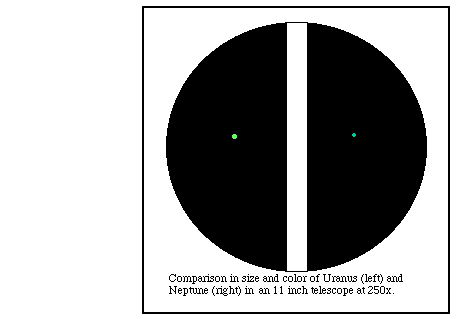
Pluto is beyond the reach of small telescopes,
and even in large telescopes has no apparent disk. It wanders about the
sky as a fourteenth magnitude speck, giving off about a thousandth of the
light of the faintest stars visible to the naked eye.
The planets are not the only wandering worlds from our
solar system visible in small telescopes. Quite a few of the asteroids
are bright enough to be glimpsed in a small 'scope, and Vesta (the
brightest asteroid) is sometimes visible to the naked eye, but none of
these can be resolved into disks. On occasion, an asteroid will pass in
front of a star as seen from Earth (this is called an occultation).
If the asteroid is so faint that it cannot be seen directly, the star appears
to "go out".
More interesting to most observers are the comets.
© Copyright Info


